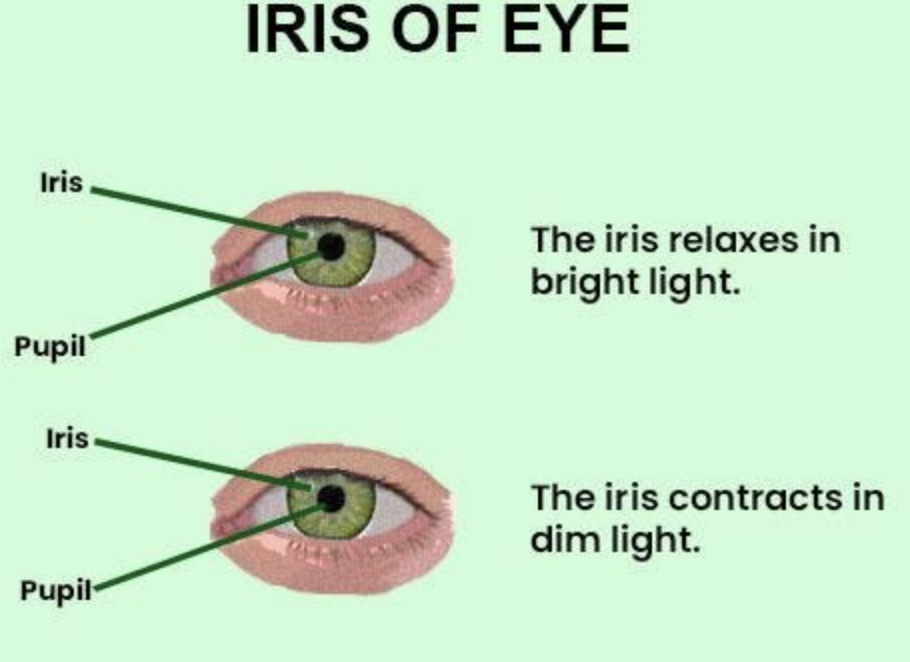Answer
395.4k+ views
Hint: We struggle to see when we switch from dark to light for some time, but due to adjustment, vision soon becomes normal. Any adjustment or improvement to the usual scenario is an example of such a condition and the specific organism is still able to survive under that condition.
Complete answer:
Adaptation is the eye's ability to concentrate according to various light intensities. The retina has photoreceptor cells that detect the strength of light. Two kinds of photoreceptor cells, cones, and rods, are present. Daylight vision and color vision are associated with cones, while scotopic vision is associated with rods, i.e. vision in low light. These cones and rods are triggered at high and low light intensities, respectively, if the light intensity varies from high to low or vice versa. The eye adapts itself to various intensities of light to concentrate.

The rod cells of the eye produce a purple pigment called rhodopsin, or visual purple. In the dim light and at night, they work. Rhodopsin is divided into a lipoprotein scotopsin and a carotenoid retinene pigment by bright light. The rod cell is depolarised by the splitting of rhodopsin. Rhodopsin is synthesised from "scotopsin and retinene" in the dark. It is called dark adaptation. It allows rods to be functional. Rhodopsin needs some time to be restructured. This is why we feel blind for a moment when we reach a dark space in the daytime or when we come out of a well-lit room at night. We have trouble seeing properly for a moment as we go from darkness into bright light before rhodopsin is bleached and cones become usable.
Additional information:
- Accommodation is a reflex process in which the focus of the eye shifts to sharpen the images on the retina of distant and close objects.
- Mutation is a change in a cell's genetic material (DNA) or a change in an individual's characteristics that is not caused by natural genetic processes.
- Photoperiodism is an organism's reaction to the cycle of the day.
So, the correct answer is, ‘(b) Adaptation’.
Note: In visual physiology, adaptation is the ability of the eye's retina to respond to different light levels. In low-light settings, normal night vision, or scotopic vision, is the ability to see. It takes some time for rhodopsin to break into scotopsin and retinal (bleaching) in adaptation, and release the transmitter passing nerve impulse to the optic nerves through bipolar and ganglion cells.
Complete answer:
Adaptation is the eye's ability to concentrate according to various light intensities. The retina has photoreceptor cells that detect the strength of light. Two kinds of photoreceptor cells, cones, and rods, are present. Daylight vision and color vision are associated with cones, while scotopic vision is associated with rods, i.e. vision in low light. These cones and rods are triggered at high and low light intensities, respectively, if the light intensity varies from high to low or vice versa. The eye adapts itself to various intensities of light to concentrate.

The rod cells of the eye produce a purple pigment called rhodopsin, or visual purple. In the dim light and at night, they work. Rhodopsin is divided into a lipoprotein scotopsin and a carotenoid retinene pigment by bright light. The rod cell is depolarised by the splitting of rhodopsin. Rhodopsin is synthesised from "scotopsin and retinene" in the dark. It is called dark adaptation. It allows rods to be functional. Rhodopsin needs some time to be restructured. This is why we feel blind for a moment when we reach a dark space in the daytime or when we come out of a well-lit room at night. We have trouble seeing properly for a moment as we go from darkness into bright light before rhodopsin is bleached and cones become usable.
Additional information:
- Accommodation is a reflex process in which the focus of the eye shifts to sharpen the images on the retina of distant and close objects.
- Mutation is a change in a cell's genetic material (DNA) or a change in an individual's characteristics that is not caused by natural genetic processes.
- Photoperiodism is an organism's reaction to the cycle of the day.
So, the correct answer is, ‘(b) Adaptation’.
Note: In visual physiology, adaptation is the ability of the eye's retina to respond to different light levels. In low-light settings, normal night vision, or scotopic vision, is the ability to see. It takes some time for rhodopsin to break into scotopsin and retinal (bleaching) in adaptation, and release the transmitter passing nerve impulse to the optic nerves through bipolar and ganglion cells.
Recently Updated Pages
In a flask the weight ratio of CH4g and SO2g at 298 class 11 chemistry CBSE

In a flask colourless N2O4 is in equilibrium with brown class 11 chemistry CBSE

In a first order reaction the concentration of the class 11 chemistry CBSE

In a first order reaction the concentration of the class 11 chemistry CBSE

In a fermentation tank molasses solution is mixed with class 11 chemistry CBSE

In a face centred cubic unit cell what is the volume class 11 chemistry CBSE

Trending doubts
Which are the Top 10 Largest Countries of the World?

Difference Between Plant Cell and Animal Cell

Give 10 examples for herbs , shrubs , climbers , creepers

Fill the blanks with the suitable prepositions 1 The class 9 english CBSE

Write a letter to the principal requesting him to grant class 10 english CBSE

Difference between Prokaryotic cell and Eukaryotic class 11 biology CBSE

What is the full form of AD a After death b Anno domini class 6 social science CBSE

Change the following sentences into negative and interrogative class 10 english CBSE

Name 10 Living and Non living things class 9 biology CBSE



